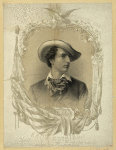Posts Tagged ‘Nativism’
On Know Nothings and Secret Societies – 8
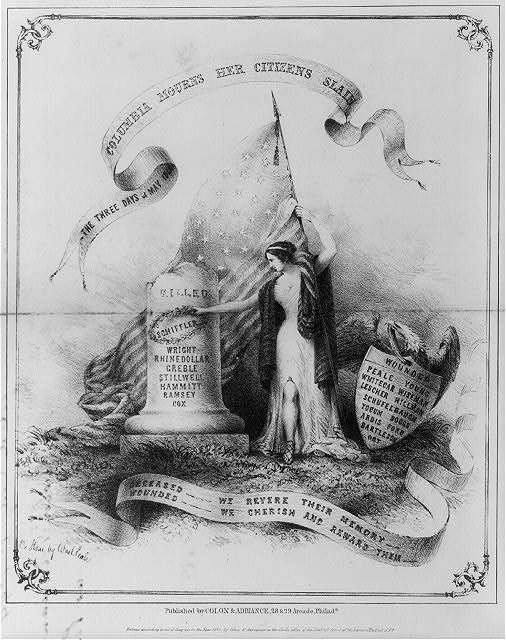
The three days of May 1844. Columbia mourns her citizens slain. Source: Library of Congress
Few would argue that a resurgence of nativism in the mid-19th century had a rational footing. It was, rather, “a nonrational response to contemporary problems” in “an age of social upheaval, an age of deprivation, stress, and imminent disaster.”
The nation was not facing civil war because of immigration from Ireland and Germany. The dislocations of urban-industrial growth were not produced by the newcomers, more victims than villains in this story. Attacking the Irish would not resolve the dilemma of sectional strife. Striking out at the aliens would not bring an end to socioeconomic changes or even the illusion of stability.
But embracing an antialien movement would allow frustrated nativists a sense of “escape from the central problems of their time. Unwilling to accept the dark side of their American experience—the wages of slavery, the stresses of a competitive culture, the crisis of community—they struck out at the most vulnerable group within their midst.” Thus Bennett posits, “the Know Nothing movement and the great appeal of nativism are found in concerns about immigration and historic fears of Catholicism.”
Many nativists thought the solution to the growing turmoil was to return to that which was familiar in the nation’s past, waging battle against an invading alien threat.
Americanists constructed a polarized world in which the enemy (now Catholic Irish and Germans) was an alien intruder and they were the “chosen people.”
In the end, Bennett asserts, the membership of the American Party would discover that “the issues over which they differed were as important as the religious, ethnic, and political bonds that united them.” Even though they achieved considerable early success as a party, they had not found a way to handle the great divisive issue of the day, slavery.
David H. Bennett, The Party Of Fear: The American Far Right from Nativism to the Militia Movement , (Chapel Hill, NC: University of North Carolina Press, 1988), 94, 103, 119.
About the image.
A memorial to nativist casualties of the violent clashes occurring between anti-foreigner “Native Americans” and Irish-American Catholics in Kensington, Philadelphia, May 6 through 8, 1844. The female figure of Columbia holds a large, billowing American flag near a broken column on which she places a wreath. On the column are the names of those Native Americans killed during the attacks on Catholic homes and institutions. At the top of the list, circled by Columbia’s wreath, is the name of George Schiffler, the first and most famous of the nativist martyrs. Other names inscribed on the column are: Wright, Rhinedollar, Greble, Stillwell, Hammitt, Ramsey, and Cox. To the right of Columbia is an American eagle supporting a shield with the names of the wounded, including: Peale (the artist?), Whitecar, Lescher, Young, Wiseman, Willman, Schufelbaugh, Yocum, Ardis, Boggs, Ford, Bartleson, and Ort. Above the figure floats a streamer with the print’s title. Below a similar banner reads “Deceased—-We Revere Their Memory—Wounded—We Cherish And Reward Them—.”
Medium: lithograph on wove paper
Published by Colon & Adriance, 28 & 29 Arcade, 1844.
Library of Congress Call Number: LOT 10615-34 [item] [P&P]
On Know Nothings and Secret Societies – 7
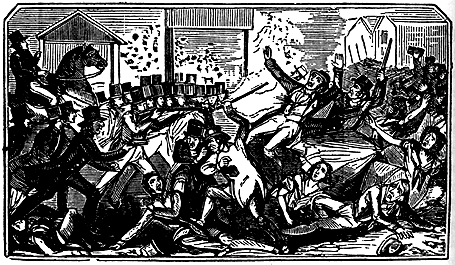
Fight between the Rioters in Kennsington. Source: The Historical Society of Pennsylvania. From: "A Full and Complete Account of the Late Awful Riots in Philadelphia." Philadelphia: John B. Perry, 1844.
Social historian David H. Bennett provides an in-depth view of the Know Nothing Party’s origins and attempts to get at the reasons for its emergence in his outstanding book, The Party Of Fear: The American Far Right from Nativism to the Militia Movement. He points to the incredible social upheaval occurring in America in the mid-19th century. Drawing from analysis of the way that people deal with change, Bennett points to the growing sense of a loss of control over personal destiny experienced by many native born American men, the complete antithesis of the self-deterministic opportunities upon which the nation was formed. The result was xenophobia, the target those who were not native born and the largest immigrant groups by the 1850’s were Irish and German.
Immigrants proved the perfect target for many Americans in these troubled times. They could associate their own loss of power or status with the emergence of a subversive group disrupting time-honored relationships. In a social order threatened by catastrophe, polarization between the forces of good and evil satisfied the desire for enemies on whom to pin the blame, whose defeat could restore the stability of the cherished past.
(1) David H. Bennett, The Party Of Fear: The American Far Right from Nativism to the Militia Movement , (Chapel Hill, NC: University of North Carolina Press, 1988), 107.
On Know Nothings and Secret Societies – 6
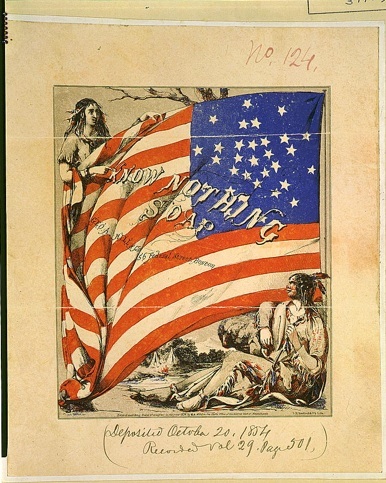
Know-Nothing Soap, Library of Congress, Repository: Library of Congress Prints and Photographs Division Washington, D.C. 20540 USA http://hdl.loc.gov/loc.pnp/pp.print
With the election of 1854, a stunning demonstration of the Know Nothings’ magnetic appeal, nativism became a new American rage.
Know Nothing candy, Know Nothing tea, and Know Nothing toothpicks were marketed, buses and stagecoaches received the charmed name, the clipper ship Know Nothing was launched in New York. Books appeared with “KN” on the cover, “Know Nothing” poems found easy publication, and the widely circulated Know Nothing Almanac or True American’s Manual was issued. The Almanac had schedules for sunset and moon phases mixed with a potpourri of nativist polemics, including stories of Catholic machinations in Ireland, statistics of foreigners in the almshouses and charity hospitals, as well as warnings of every kind of alien conspiracy. (1)
What had humble beginnings, as a fraternity, was now the American party. “Those in the movement remained proud of the secret order at the heart of the political organization.” (1)
——
(1) David H. Bennett, The Party of Fear: From Nativist Movements to the New Right in American History, 115.
About the image: An illustrated advertising label for soap manufactured in Boston, interesting for its imagery and allusion to the popular “Know Nothing” or nativist movement. In the foreground are two American Indians, emblematic of the movement’s prejudice against the foreign-born. In the lower right is a seated brave, leaning against a rock and holding a pipe. Above him a large American flag, with thirty-one stars, unfurls across the main picture area. The flag is supported in the upper left corner by an Indian woman, who points to the words “Know Nothing Soap” emblazoned on it. In the background is a landscape with tepees and a campfire on the bank of a stream.
Medium: 1 print : lithograph printed in red, grey, blue, and black on coated paper ; 15.2 x 12.6 cm. (image)
Created/Published:1854.
On Know Nothings and Secret Societies – 2

In the 1830s and 1840s, Americans had rediscovered a fascination with fraternalism discarded earlier in the century “when anti-Masonry led to public suspicion of secret societies.” (1) This was the era of the Odd Fellows, the Foresters, the Good Fellows and the Druids, the Red Men and the Heptasops. (2)
James McPherson marks the beginning of the movement that would lead to the “Know Nothing” American Party in the 1840s, when nativist parties flared and then cooled after the elections of 1844. (3) Relief from depression calmed tensions between native and foreign-born workers just in time for the massive influx of Europeans that resulted from that continent’s potato blight. (4) But American nativist sentiments continue to simmer and “on a late December evening in 1844, thirteen men gathered in the home of printer Russell C. Root in New York City” to form a group calling itself the American Brotherhood. The name was eventually changed to “Order of United Americans (OUA).” Its goals, outlined in a “code of principles,” were “to release our country from the thralldom of foreign domination.” This marked the birth of a nativist fraternity…and formed the nucleus of a far larger nativist effort than ever before. (5)
Membership in the Order of United Americans was limited to white men, twenty-one years of age or older, native born and Protestant. Its leaders were reasonably affluent and good organizers albeit from the “margins of the establishment.” This was a secret society replete with mysterious rituals and procedures that gave it an “illusion of antiquity.” (6)
Central to its structure was the magical triad. There were three levels of authority (local chapter, state chancery, and national archchancery), three chancellors sent from chapter to chancery, three archchancellors sent on to national. But there was only one leader of the OUA (limited to a single year term) and in the language of the lodge vogue he was called the arch grand sachem. By 1850, he ruled over a truly national domain with groups in New York, Pennsylvania, Massachusetts, New Jersey, Connecticut, Missouri, and Ohio. (6)
Gradually the organization began to become politicized and attracted “many conservative Whigs whose nativist ideology conveniently intersected with political needs in a time of party disarray.” (7)
—
1. David H. Bennett, The Party Of Fear: The American Far Right from Nativism to the Militia Movement (Chapel Hill, NC: University of North Carolina Press, 1988), 106.
2. Ibid.
3. James McPherson, Battle Cry of Freedom: The Civil War Era, (New York: Oxford Press, 1988), 130.
4. Ibid.
5. David H. Bennett, The Party of Fear: From Nativist Movements to the New Right in American History, 105.
6. Ibid, 107.
7. Ibid., 110.
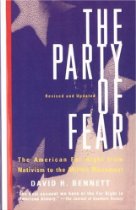
 In the spring of 1850, another nativist fraternity, The Order of the Star Spangled Banner (OSSB) was founded in New York City by Charles B. Allen, a thirty-four-year-old commercial agent born and educated in Massachusetts. (1) At first a simple “local fellowship numbering no more than three dozen men, there was little to distinguish their order from many other ‘patriotic’ groups, little reason for anyone to expect that it would be the core of a major political party, the greatest achievement of nativism in America.” (1) By 1852, it began to grow quickly and leaders of the Order of United Americans (OUA) took notice. Many of their membership joined and the OSSB membership swelled “from under fifty to a thousand in three months.” (1) Later that year, the two organizations joined under the leadership of James Barker and, with astute organizational skill, hundreds of lodges were formed “all over the country with an estimated membership ranging up to a million or more.” (2) Those who joined promised, as a part of secret rituals, to “vote for no one except native-born Protestants for public office” and “the Order endorsed certain candidates or nominated its own” in secret councils. Because their rules required them to say they “knew nothing” about the organization if asked, the movement became known as the “Know Nothings” (3)
In the spring of 1850, another nativist fraternity, The Order of the Star Spangled Banner (OSSB) was founded in New York City by Charles B. Allen, a thirty-four-year-old commercial agent born and educated in Massachusetts. (1) At first a simple “local fellowship numbering no more than three dozen men, there was little to distinguish their order from many other ‘patriotic’ groups, little reason for anyone to expect that it would be the core of a major political party, the greatest achievement of nativism in America.” (1) By 1852, it began to grow quickly and leaders of the Order of United Americans (OUA) took notice. Many of their membership joined and the OSSB membership swelled “from under fifty to a thousand in three months.” (1) Later that year, the two organizations joined under the leadership of James Barker and, with astute organizational skill, hundreds of lodges were formed “all over the country with an estimated membership ranging up to a million or more.” (2) Those who joined promised, as a part of secret rituals, to “vote for no one except native-born Protestants for public office” and “the Order endorsed certain candidates or nominated its own” in secret councils. Because their rules required them to say they “knew nothing” about the organization if asked, the movement became known as the “Know Nothings” (3)
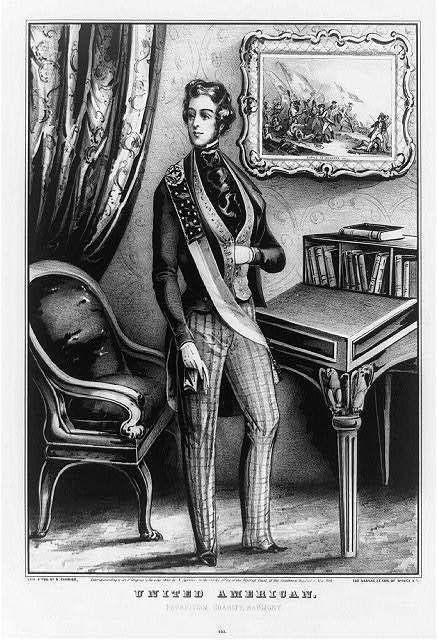 Bits of white paper strewn across a prearranged site announced the meeting of the brotherhood. Held at night, in keeping with the secrecy that shrouded its early years, the sessions of the local chapters of the Order of the Star Spangled Banner were open only to initiates and those about to join them in the ranks. The ritual for admission to the lodge seemed endless. But instead of irritating men tired after a long day’s work, the elaborate raps and special handclasps, the passwords between brothers, and the sentinels sent to escort candidates long known to the membership seemed to heighten the feeling of camaraderie, the sense of special excitement at the dangerous but essential mission they were privileged to share. For they were there to save and cleanse the nation, to preserve for themselves that abstraction which some would later call the American dream.
Bits of white paper strewn across a prearranged site announced the meeting of the brotherhood. Held at night, in keeping with the secrecy that shrouded its early years, the sessions of the local chapters of the Order of the Star Spangled Banner were open only to initiates and those about to join them in the ranks. The ritual for admission to the lodge seemed endless. But instead of irritating men tired after a long day’s work, the elaborate raps and special handclasps, the passwords between brothers, and the sentinels sent to escort candidates long known to the membership seemed to heighten the feeling of camaraderie, the sense of special excitement at the dangerous but essential mission they were privileged to share. For they were there to save and cleanse the nation, to preserve for themselves that abstraction which some would later call the American dream.